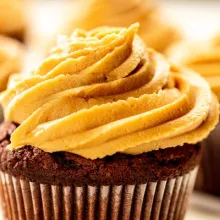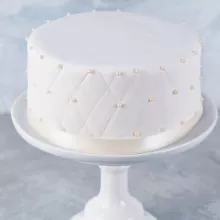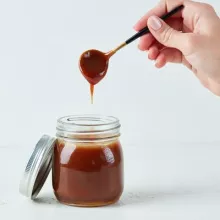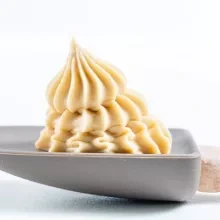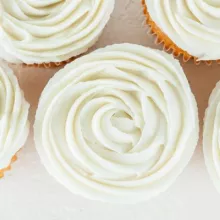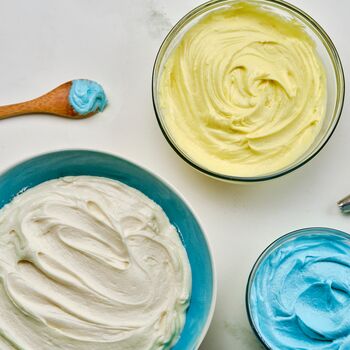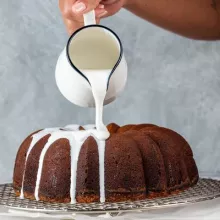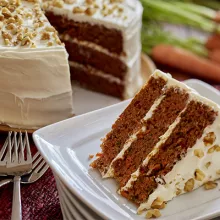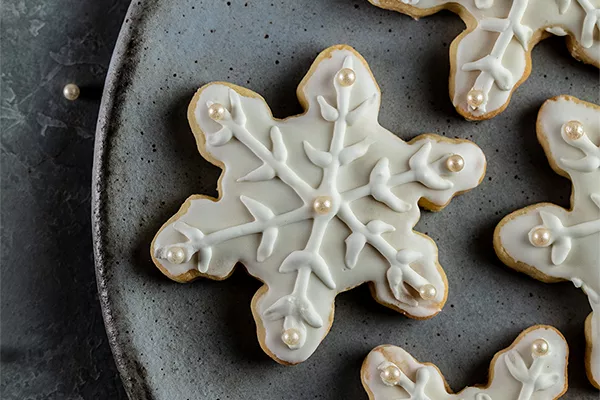Categories: | Frosting, Icing & Glazes | Everyday Baking
Glazing a cake is the finishing touch that elevates it from good to great. A well-made glaze not only adds a layer of sweetness but also enhances the flavor and creates a visually appealing presentation. However, achieving that perfect glossy finish can sometimes feel daunting. This beginner's guide will walk you through the process of making a glaze, ensuring your cakes always look and taste amazing.

Baked by Angela Chung @momentsofsugar
What is a Glaze?
Glazes are used to give desserts a smooth or shiny finish. A glaze is usually drizzled onto a cake or applied with a pastry brush to give a glisten to pastries. Glazes also add a shiny look to fruit pies and tarts.
A basic glaze contains powdered’ sugar and a liquid such as water or milk. More liquid is added for a thinner glaze. Flavor can be added with melted chocolate, extracts, jams, or fruit juice.

Tips for Making a Glaze with Domino® Powdered Sugar
- Cool downtime is crucial. Cake should be at room temperature or slightly chilled. Warm cakes will melt the glaze, making it runny and inconsistent. Allow the cake to cool completely to room temperature before proceeding. This ensures the glaze sets properly and maintains its desired texture.
- Prepare for a mess-free clean-up. Put a piece of parchment or wax paper under the cake to catch drips. This makes it much easier to clean up after you have finished glazing your cakes or baked goods.
- Master the perfect glaze consistency. If the glaze is too thick, it will be difficult to spread and may crack, which can cause an uneven finish. If the glaze is too thin, then it will run off the cake and prevent proper setting. Aim for a pourable consistency that smoothly coats the cake without excessive dripping. You can easily adjust the consistency by adding more liquid (water, juice, milk) to thin it or more powdered sugar to thicken it.
- Apply the glaze quickly and evenly. Pour glaze on the center of the cake. Allow excess to drip off the cake. Touch glaze as infrequently as possible to avoid picking up crumbs. Glaze sets quickly, so if you're applying decorations or toppings such as nuts, do so immediately after glazing. Use a spatula or the back of a spoon to gently spread the glaze evenly over the cake. Avoid overworking the glaze because this can incorporate air bubbles and make it lumpy.
- Allow the glaze to set. Once your baked goods have been glazed, allow them to set for at least 2 hours at room temperature. Glazes require time to fully solidify to prevent smudging or transferring when handled or cut. This setting time ensures a clean, professional finish and a more enjoyable eating experience.
Domino® Powdered Sugar Glaze Recipes
Domino® Powdered Sugar Glaze Recipes
Try out these baking tips with a classic Domino® Powdered Sugar glaze recipe or get creative with any of these tasty glaze recipes:
- Lemon Poppy Seed Loaf Cake with Lavender Glaze
- Gingerbread Bundt Cake with Maple Glaze
- Olive Oil Cake with Aperol Spritz Glaze
Experiment with different flavor combinations and decorative touches to discover your own unique glaze recipe. You can enhance the glaze with extracts like vanilla, almond, lemon, or orange for a subtle flavor boost. Or, try incorporating fruit juices such as lemon, orange, or cranberry for a refreshing twist. Lastly, add zest of citrus fruits like lemon or orange for a bright and zesty flavor.
By following these simple tips and techniques to make a glaze, you can confidently create delicious and beautifully glazed baked goods like cakes, pies, tarts, and more delicious pastries. Happy baking!


